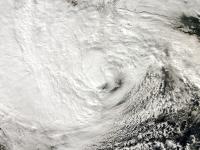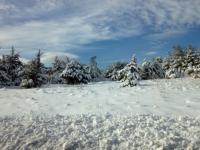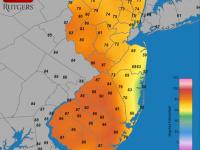
High Point Solutions Stadium at Rutgers University. (Photo: Wikipedia)
On July 1, Rutgers University officially becomes a member of the Big Ten Conference. In doing so, the Scarlet Knights join thirteen other schools in the Big Ten, bringing with it "new opportunities for academic collaboration and athletic competition."
In the spirit of that friendly, scholastic competition, we are putting the 14 Big Ten schools head-to-head in a weather and climatology showdown! Which school in which city and which state is the hottest? The coldest? The wettest? The snowiest? Keep scrolling to find out!
The Big Ten: A Hub for Weather and Climate
In addition to a long-standing tradition of outstanding athletics and academics, 10 of the 14 universities in the Big Ten are home to their respective state's climate office. Each state climatologist serves as a focal point for all activities pertaining to the weather and climate of their state. The Office of the New Jersey State Climatologist at Rutgers University is proud to be among some great climatological company in the Big Ten.
| Big Ten universities home to a State Climate Office | ||
|---|---|---|
| School, City, State | State Climate Office | |
| Rutgers, The State University of New Jersey New Brunswick / Piscataway, NJ |
Office of the NJ State Climatologist | |
| University of Illinois at Urbana-Champaign Urbana / Champaign, IL |
Illinois State Climatologist Office | |
| University of Maryland College Park, MD |
Maryland State Climatologist's Office | |
| Michigan State University East Lansing, MI |
Michigan State Climatologist's Office | |
| University of Minnesota Minneapolis / St. Paul, MN |
Minnesota State Climatology Office | |
| University of Nebraska-Lincoln Lincoln, NE |
Nebraska State Climate Office | |
| Ohio State University Columbus, OH |
The State Climatology Office for Ohio | |
| Pennsylvania State University University Park, PA |
Pennsylvania State Climatologist | |
| Purdue University West Lafayette, IN |
Indiana State Climate Office | |
| University of Wisconsin-Madison Madison, WI |
Wisconsin State Climatology Office | |
| Big Ten universities without a State Climate Office on campus | ||
|---|---|---|
| School, City, State | State Climate Office | |
| Indiana University Bloomington, IN |
located at Purdue University, West Lafayette, IN | |
| University of Iowa Iowa City, IA |
Iowa State Climatologist's Office located at the Iowa Dept. of Agriculture and Land Stewardship |
|
| University of Michigan Ann Arbor, MI |
located at Michigan State University, East Lansing, MI | |
| Northwestern University Evanston, IL |
located at University of Illinois, Champaign, IL | |
Methodology
Summary data in the tables below have been calculated from one representative weather station near each school. Each school's station is determined according to the following criteria:
- NWS Cooperative Network station
- actively reporting as of 2014
- as close as possible to a school's primary football stadium
- has at least 30 complete years of historical data
- has published 1981-2010 climate normals for temperature, precipitation, and snowfall
| Weather Stations used in Analysis | ||
|---|---|---|
| School | Nearest Station | Period of Record |
| Illinois | #118740: URBANA | 1888 - 2014 (126 years) |
| Indiana | #120784: BLOOMINGTON IND UN | 1895 - 2014 (119 years) |
| Iowa | #134101: IOWA CITY | 1893 - 2014 (121 years) |
| Maryland | #180700: BELTSVILLE | 1941 - 2014 (73 years) |
| Michigan | #200230: ANN ARBOR U OF MI | 1881 - 2014 (133 years) |
| Michigan State | #204641: LANSING CAPITAL CITY AP | 1948 - 2014 (66 years) |
| Minnesota | #215435: MINNEAPOLIS/ST PAUL AP | 1938 - 2014 (76 years) |
| Nebraska | #254795: LINCOLN MUNI AP | 1948 - 2014 (66 years) |
| Northwestern | #111497: CHICAGO BOTANICAL GARDEN | 1981 - 2014 (33 years) |
| Ohio State | #331786: COLUMBUS PORT COLUMBUS INTL AP | 1948 - 2014 (66 years) |
| Penn State | #368449: STATE COLLEGE | 1893 - 2014 (121 years) |
| Purdue | #129430: WEST LAFAYETTE 6 NW | 1901 - 2014 (113 years) |
| Rutgers | #286055: NEW BRUNSWICK 3 SE | 1968* - 2014 (46* years) |
| Wisconsin | #471416: CHARMANY FARM | 1959 - 2014 (55 years) |
*NOTE: The New Brunswick climate record is a bit odd, because the official weather station was issued new ID numbers in 1912 and 1968. Thus, even though an almost-continuous climate record exists for New Brunswick from 1896 to present day, the most recent station ID (286055) has only been active since 1968. For this analysis, averages and normals have been computed for the most recent period, while extreme values use the entire period of record.
The Warmest
While most students may be away from campus for Summer Break, some of the Big Ten schools get downright steamy in the summertime. The dry, windy furnace of the Central Plains pushes Nebraska to the top of list in terms of hottest average July high temperatures. Meanwhile, in terms of extreme temperatures, every Big Ten city has exceeded 100 degrees at some point in its history. The hottest single day temperature occurred near Purdue during the Dust Bowl era in July 1936: a scorching 111 degrees. Note that both Indiana and Iowa also posted their all-time high temperature in July 1936.
| Average July Maximum Temperature | |||
|---|---|---|---|
| Rank | School | Temp (°F) | |
| 1 | Nebraska | 89.0 | |
| 2 | Maryland | 87.7 | |
| 3 | Iowa | 87.0 | |
| 4 | Rutgers | 85.6 | |
| 5 | Indiana | 85.4 | |
| 6 | Illinois | 85.0 | |
| 7 | Ohio State | 84.9 | |
| 8 | Purdue | 84.0 | |
| 9 | Minnesota | 83.4 | |
| 10 | Michigan | 83.2 | |
| 11 | Northwestern | 82.6 | |
| 12 | Michigan State | 82.4 | |
| 13 | Wisconsin | 82.0 | |
| 14 | Penn State | 81.6 | |
| Hottest Daily Temperature | ||||
|---|---|---|---|---|
| Rank | School | Temp (°F) | Date | |
| 1 | Purdue | 111 | 1936-07-14 | |
| 2 | Indiana | 110 | 1936-07-15 | |
| 3 | Illinois | 109 | 1954-07-14 | |
| 3 | Iowa | 109 | 1936-07-14 | |
| 5 | Nebraska | 108 | 2006-07-19 | |
| 6 | Rutgers | 106 | 1918-08-07 | |
| 7 | Michigan | 105 | 1934-07-24 | |
| 7 | Minnesota | 105 | 1988-07-31 | |
| 7 | Northwestern | 105 | 2012-07-06 | |
| 10 | Ohio State | 104 | 1954-07-14 | |
| 11 | Maryland | 103 | 1988-07-17 | |
| 11 | Michigan State | 103 | 2012-07-06 | |
| 11 | Wisconsin | 103 | 2012-07-07 | |
| 14 | Penn State | 102 | 1988-07-17 | |
The Coldest
Not surprisingly, the northern winter wonderlands of Minnesota and Wisconsin top both the coldest average January low temperatures and the coldest daily temperature lists. According to the National Weather Service, a temperature of -34°F and a light wind at 10 mph can cause dangerous frostbite in just 10 minutes. For other schools that are further south or near large bodies of water (such as the Atlantic Ocean or Great Lakes), winter temperatures are moderated and not as extreme.
| Average January Minimum Temperature | |||
|---|---|---|---|
| Rank | School | Temp (°F) | |
| 1 | Minnesota | 7.5 | |
| 2 | Wisconsin | 10.7 | |
| 3 | Nebraska | 13.8 | |
| 4 | Iowa | 14.0 | |
| 5 | Northwestern | 15.9 | |
| 6 | Purdue | 16.5 | |
| 7 | Illinois | 16.7 | |
| 8 | Michigan State | 16.8 | |
| 9 | Michigan | 17.9 | |
| 10 | Penn State | 20.2 | |
| 11 | Indiana | 20.4 | |
| 12 | Rutgers | 21.8 | |
| 13 | Ohio State | 22.6 | |
| 14 | Maryland | 23.7 | |
| Coldest Daily Temperature | ||||
|---|---|---|---|---|
| Rank | School | Temp (°F) | Date | |
| 1 | Minnesota | -34 | 1970-01-19 | |
| 1 | Wisconsin | -34 | 1994-01-19 | |
| 3 | Nebraska | -33 | 1974-01-12 | |
| 4 | Iowa | -32 | 1905-02-13 | |
| 5 | Michigan State | -29 | 1981-01-04 | |
| 6 | Northwestern | -27 | 1982-01-10 | |
| 7 | Illinois | -25 | 1999-01-05 | |
| 8 | Purdue | -24 | 1985-01-21 | |
| 9 | Michigan | -23 | 1885-02-11 | |
| 10 | Ohio State | -22 | 1994-01-19 | |
| 11 | Indiana | -21 | 1985-01-21 | |
| 12 | Penn State | -20 | 1899-02-10 | |
| 13 | Rutgers | -16 | 1934-02-09 | |
| 14 | Maryland | -15 | 1957-01-18 | |
The Wettest
Rutgers takes home the crown for the highest average annual precipitation, thanks to the influence of both tropical (ocean-based) and continental (land-based) weather systems. The highest 1-day rainfall total in the Big Ten occurred at Maryland in August 13, 1955 as a result of Hurricane Connie, which caused massive flooding across much of the mid-Atlantic region. The second place 1-day total from Minnesota was a result of the 1987 Twin Cities Superstorm and the 7.96" daily rainfall record at Rutgers came from Tropical Storm Irene in 2011.
| Average Annual Precipitation | |||
|---|---|---|---|
| Rank | School | Precip (in.) | |
| 1 | Rutgers | 48.93 | |
| 2 | Indiana | 47.36 | |
| 3 | Maryland | 41.84 | |
| 4 | Illinois | 41.38 | |
| 5 | Penn State | 39.62 | |
| 6 | Ohio State | 39.31 | |
| 7 | Purdue | 38.19 | |
| 8 | Northwestern | 37.75 | |
| 9 | Iowa | 37.59 | |
| 10 | Michigan | 37.56 | |
| 11 | Wisconsin | 36.13 | |
| 12 | Michigan State | 31.77 | |
| 13 | Minnesota | 30.61 | |
| 14 | Nebraska | 28.95 | |
| Greatest Daily Precipitation Total | ||||
|---|---|---|---|---|
| Rank | School | Precip (in.) | Date | |
| 1 | Maryland | 9.38 | 1955-08-13 | |
| 2 | Minnesota | 9.15 | 1987-07-23 | |
| 3 | Rutgers | 7.96 | 2011-08-28 | |
| 4 | Iowa | 6.91 | 1962-07-14 | |
| 5 | Indiana | 6.56 | 1913-03-25 | |
| 6 | Wisconsin | 5.85 | 2001-08-02 | |
| 7 | Northwestern | 5.54 | 1987-08-14 | |
| 8 | Nebraska | 5.42 | 1990-07-25 | |
| 9 | Illinois | 5.32 | 1993-08-12 | |
| 10 | Ohio State | 5.13 | 1992-07-13 | |
| 11 | Penn State | 5.05 | 2004-09-18 | |
| 12 | Michigan State | 4.95 | 1986-06-11 | |
| 13 | Purdue | 4.85 | 1939-07-18 | |
| 14 | Michigan | 4.54 | 1998-08-06 | |
The Snowiest
From southwest to northwest, there is a large range of snowfall conditions across the Big Ten. Michigan edges Minnesota in the overall race for average seasonal snowfall, likely due to the influence of lake-effect snow from the Great Lakes. Meanwhile, Rutgers, on average, only experiences about half the snowfall of Michigan and Maryland sees about a quarter of Michigan's total. The Big Ten snowstorm award goes to Penn State, however, as a late-season snowstorm in March 1994 dumped over two feet of snow in one day, capping off one the snowiest seasons of all time for the Northeast US. Every one of the Big Ten schools has seen a one-day snow total over a foot.
| Average Seasonal Snowfall | |||
|---|---|---|---|
| Rank | School | Snow (in.) | |
| 1 | Michigan | 57.3 | |
| 2 | Minnesota | 54.4 | |
| 3 | Michigan State | 51.1 | |
| 4 | Penn State | 45.6 | |
| 5 | Wisconsin | 37.9 | |
| 6 | Northwestern | 33.4 | |
| 7 | Rutgers | 28.4 | |
| 8 | Iowa | 27.2 | |
| 9 | Ohio State | 26.7 | |
| 10 | Nebraska | 25.9 | |
| 11 | Illinois | 23.2 | |
| 12 | Purdue | 18.3 | |
| 13 | Indiana | 15.8 | |
| 14 | Maryland | 15.2 | |
| Greatest Daily Snowfall Total | ||||
|---|---|---|---|---|
| Rank | School | Snow (in.) | Date | |
| 1 | Penn State | 26.6 | 1994-03-03 | |
| 2 | Maryland | 22.0 | 2010-02-06 | |
| 3 | Michigan | 21.0 | 1931-02-07 | |
| 4 | Iowa | 20.0 | 1907-12-31 | |
| 5 | Rutgers | 19.8 | 2006-02-12 | |
| 6 | Minnesota | 18.5 | 1991-11-01 | |
| 7 | Indiana | 16.0 | 1904-01-26 | |
| 8 | Ohio State | 15.5 | 2008-03-08 | |
| 9 | Michigan State | 15.4 | 1967-01-26 | |
| 10 | Wisconsin | 15.0 | 1970-12-11 | |
| 11 | Illinois | 14.0 | 1906-03-20 | |
| 11 | Purdue | 14.0 | 1929-12-18 | |
| 13 | Nebraska | 13.2 | 1997-10-26 | |
| 14 | Northwestern | 13.0 | 2011-02-02 | |
Wrapping Up
So who takes home the trophy in the Big Ten Weather Championship? Minnesota takes top honors twice, both for cold temperatures, while Nebraska, Purdue, Wisconsin, Rutgers, Maryland, Michigan, and Penn State each take the top prize in one category. Iowa brought a consistent performance, ranking in the top 5 for all but two of these lists. Honorable mention goes to Illinois, Indiana, Michigan State, Northwestern and Ohio State - even though these schools finished in the middle of the pack throughout this analysis, each school's distinct climatological character deserves to be celebrated.
While the weather may vary from school to school within the Big Ten, one fact is certain... The competition among these 14 schools will be heating up on the field this fall!






